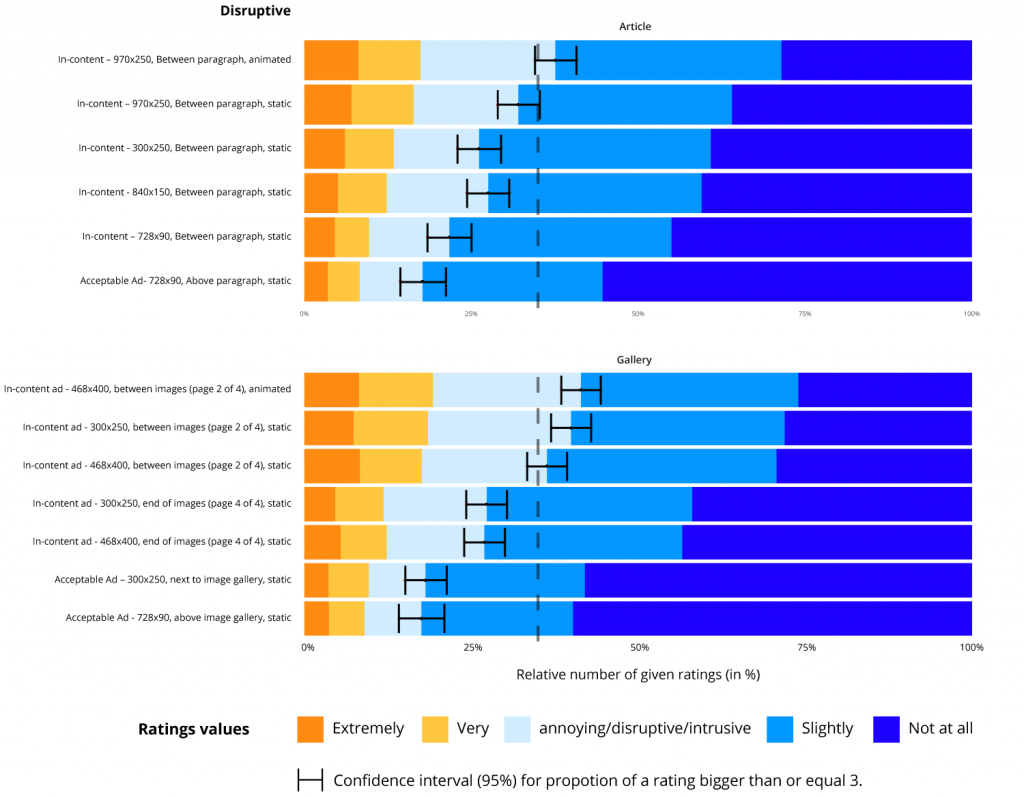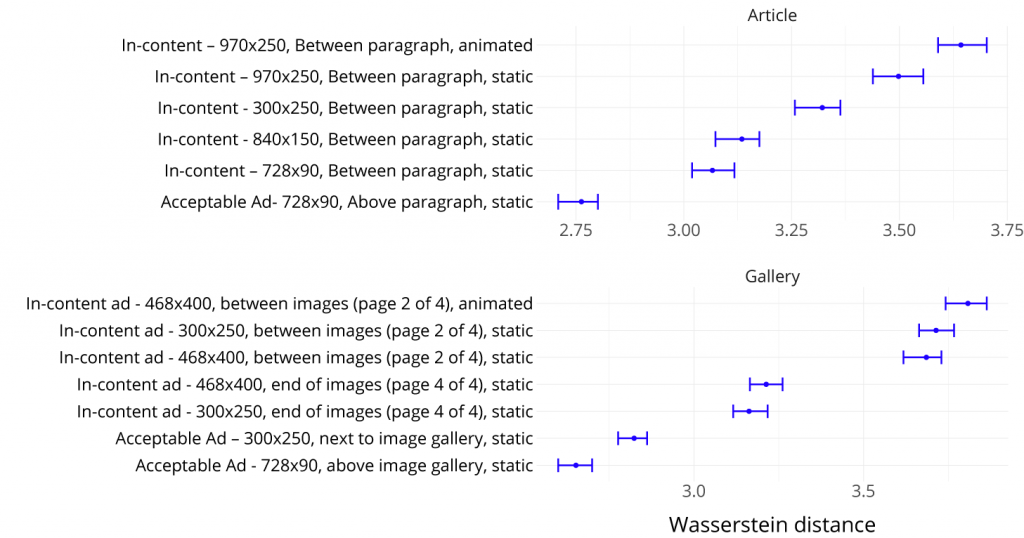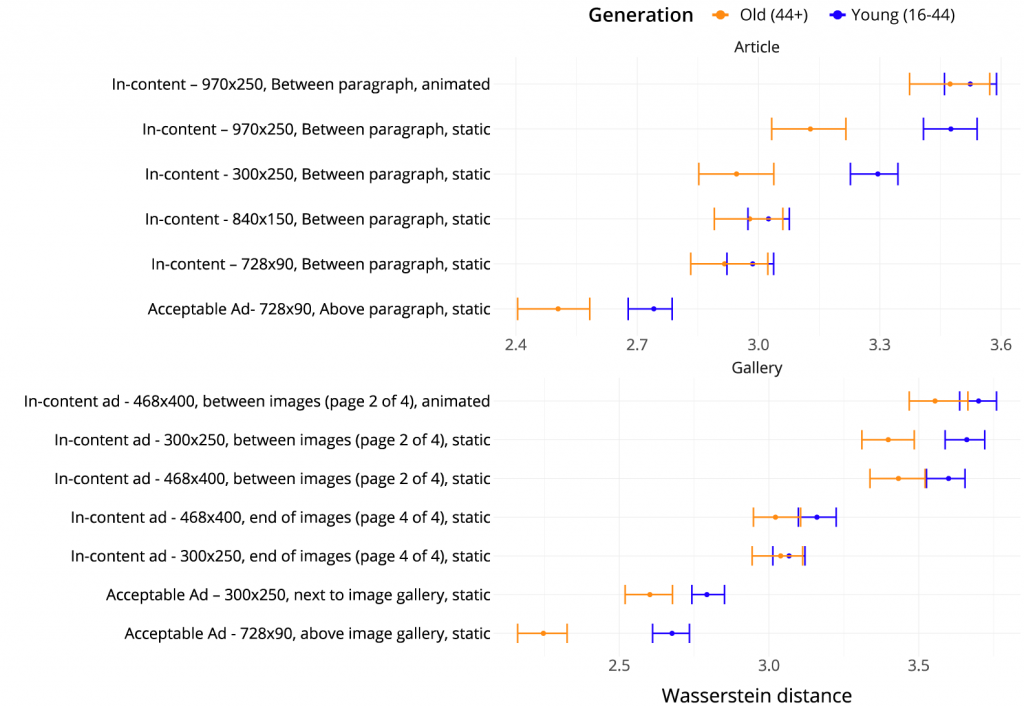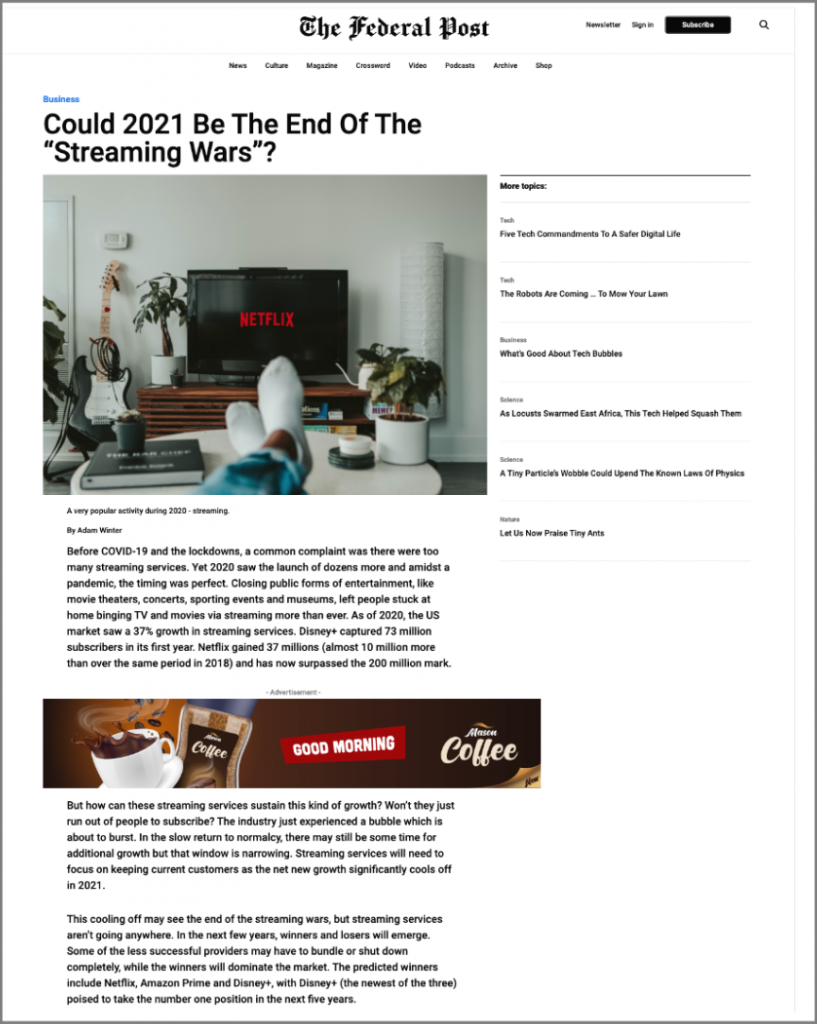1. Introduction
The Acceptable Ads Standard ensures that ads do not interfere negatively with users’ web experience. In order to suggest changes to the Standard, the Acceptable Ads Committee (AAC) is required to base the changes on data about users’ perceptions of new types of ads, or evolving perceptions of existing types of ads.
During the AAC’s research meeting on February 16, 2021, the AAC decided to investigate and gather data regarding ad-blocking users’ perspectives on ads placed within the primary content of a desktop webpage (in-content ads). This was done for the following reasons:
- In-content advertisement has never been closely investigated and the exclusion of this type of advertisement from the Standard is based on data dating from 2015.
- In-content advertisements are of substantial significance to the online advertising industry. A recent examination of the top 1,000 ranking Tranco domains showed that around 57% of publishers with classical editorial content for end users use such ad placements.
- The AAC’s primary goal is to create an ad standard that respects the user experience while delivering real value to content publishers and online advertisers. As these types of ads are significant to the industry, and given the lack of current insight as to their impact on users, a close investigation of in-content ad formats is an important step for the development of the Acceptable Ads Standard.
2. How can the Acceptable Ads Standard be changed?
In order to protect the integrity of the Acceptable Ads Standard and, more importantly, the user experience, any changes have to be in accordance with the AAC’s bylaws.
The process is outlined as follows:
- In the ideation phase, representatives of the AAC gather ideas on how to improve the Standard by e.g. evaluating industry developments, reviewing ideas generated by the different representatives, or analyzing feedback from ad-blocking users. All proposed changes in this phase need to be based on neutrally derived data. This data was collected within the in-content ads study referenced here.
- All representatives of the AAC have the opportunity to comment and outline their ideas/concerns regarding the suggested changes to the criteria of the Acceptable Ads Standard. It is expected that during this phase the idea(s) generated in the previous phase will be discussed. The discussion for in-content ads took place on November 30, 2021 during the AAC Research meeting.
- In order to collect further user feedback, a proposal outlining the suggested changes must be published on the AAC’s website (acceptableadscommittee.org) for the period of one month. The following chapters of this document outline the current proposal.
After all feedback has been collected, the AAC will reach a final vote to accept, amend or disregard the following proposal.
The Proposal
3. User perception of Acceptable Ads¹
This study was distributed to 9,076 ad-blocking and ad-filtering users to collect data on users’ acceptance of ads placed within the primary content of a desktop webpage.
Results show there is a clear negative impact on users’ perceptions when in-content advertisements are larger than 840×150, when advertisements are placed in the middle of a slideshow of an image gallery, or when advertisements contain animations.
In-content advertisements smaller than 840×150 or advertisements placed at the end of an image gallery slideshow do not perform² as well as the existing Standard; however, they still meet the necessary data requirements to be considered for the Acceptable Ads Standard.
¹Please note that the detailed report on users perception of in-content ads can be accessed here.
² The term “(ad) performance” within this report is used strictly in reference to the survey participants’ ratings of an ad format on the metrics studied, i.e. disruption, intrusiveness, annoyance and enjoyment. It does not refer to the revenue performance of the ad format to a publisher, nor to the performance of the ad format from an advertiser’s perspective, e.g. clickthrough, viewthrough, etc.
A. Presentation of data
Figure 1 demonstrates the level of disruptiveness of all advertising formats tested within the survey, which, according to the AAC bylaws, is the minimum requirement to determine the acceptability of an ad. More specifically: “The maximum level of acceptable annoyance shall initially be equivalent to 35 on the ‘Level of Disruption scale’(…)”
Figure 1: Disruptiveness ratings for all tested ad formats:

Additional analysis was conducted to investigate not only the level of disruption, but overall ratings of these ad formats on the other metrics analyzed as well, i.e. intrusiveness, annoyance, enjoyment. The additional analysis can be taken from Figure 2.
Figure 2: Wasserstein distance metric for the ECDF between ad types and the theoretical best ad

The confidence interval is a 95% confidence interval
Lastly, the Committee looked at the ratings for each ad format by age cohort, since younger participants tend to rate any given format more negatively than older participants. Given that ad-blocking and ad-filtering users tend to be younger, the Committee wanted to avoid the situation where it approves a format as acceptable that otherwise wouldn’t meet the acceptability threshold among younger users.
Figure 3: Wasserstein distance metric for the ECDF between ad types and the theoretical best ad grouped by age.

Based on this expanded analysis and taking, the scores of most ad formats analyzed did not meaningfully change, with one notable exception: the static 300×250 ad loaded between paragraphs moved concerningly close to the 35% threshold above which the AAC’s bylaws do not permit an ad to be deemed acceptable. Based on this further analysis, the committee decided to specifically exclude this format from the proposed changes to the Standard.
As such, the AAC proposes to include the following ad formats into the Standard:
Article Page Setting
In-content -728×90, between paragraph, static

In-content – 840×150, between paragraph, static

Gallery Page Setting
In-content ad – 300×250, end of images (page 4 of 4), static

In-content ad – 468×400, end of images (page 4 of 4), static

Further excluded from the Standard should be…
In an Article Page Setting
- In-content – 300×250, between paragraph, static (based on the extended analysis)
- In-content – 970×250, between paragraph, animated
- In-content – 970×250, between paragraph, static
In an Gallery Page Setting
- In-content ad – 468×400, between images (page 2 of 4), static
- In-content ad – 300×250, between images (page 2 of 4), static
- In-content ad – 468×400, between images (page 2 of 4), animated
B. Creating Criteria
The current Acceptable Ads Standard establishes four sets of criteria for acceptability:
- Placement of an ad.
- Ability to distinguish ads as such.
- The size of an ad.
- Specific criteria that complement the main criteria for specific advertisement types or placements.
In order for the above-mentioned advertising formats to be included in the Acceptable Ads Standard, the following changes need to be made to the placement criterion and the size criterion.
Placement criterion

Placement
Ads should not disrupt the natural reading flow. They should be placed above, beside or below the primary content¹.
¹The ‘Primary Content’ is defined as (based on the WHATWG Specification’s description of the <main>HTML element): Content that is directly related to, or expands upon the central topic of a document or the central functionality of an application. This content should be unique to the document, excluding any content that is repeated across a set of documents such as sidebars, navigation links, copyright information, site logos, and search forms (unless, of course, the document’s main function is a search form).
Given that in-content advertisements would now be allowed, this criterion becomes redundant, with the precondition that in-content advertisements have a size limit.
Size criterion
Hence, the current size criterion should be amended by adding those size provisions into the criterion listed under the ‘Size’ heading:
Size
There are strict sizes for individual ads, as well as the total space occupied by ads. All ads that are visible in the browser window when the page first loads must not collectively occupy more than 15% of the visible portion of the webpage. If placed lower on the page, ads must not collectively occupy more than 25% of the visible portion of the webpage.
Ads must also comply with size limitations, according to the ad position:
- Up to 200px high for ads above the Primary Content
- Up to 350px wide for ads adjacent to the Primary Content
- Up to 400px high for ads below the Primary Content
- Up to 150px high for ads within the Primary Content⁴
Ads must always leave sufficient space for the Primary Content on the common
screen size of 1366×768 for desktop, 360×640 for mobile devices and 768×1024 for tablets.¹²³
All ads that are placed above the fold (the portion of the webpage visible in the browser window when the page first loads under the common screen size) must not occupy in total more than 15 percent of the visible portion of the webpage. If placed below the fold, ads must not occupy in total more than 25 percent of the visible portion of the webpage.
¹ The ‘common screen size’ for desktop is 1366×768, based on data from StatCounter.
² The ‘common screen size’ for mobile is 360×640, based on data from StatCounter.
³ The ‘common screen size’ for tablets is 768×1024, based on data from StatCounter.
⁴ In the case of in-content advertising, the ad space must be pre-rendered so that the content the user consumes around it does not expand or move upon the rendering of the ad.
Changes to “Specific criteria”
For the inclusion of ads placed in the final position of a desktop carousel gallery, an addition to the section Specific criteria would be most appropriate:
06 Ads in a desktop carousel gallery
A carousel gallery is a sequence of content which the user can navigate through. Content is presented in a single image per slide style in a non-automated manner. Ads within a carousel gallery are only permitted under the following circumstances:
PLACEMENT REQUIREMENT:
Ads may only be placed after all gallery content has been viewed. Ads must be placed as the final item of the carousel gallery.
SIZE REQUIREMENT:
Ads loaded in a carousel gallery must be static display ads with a maximum width of 468px and a maximum height of 400px.
Feedback
Want to make your voice heard? Participate in the finalization of the criteria by submitting your feedback below or by reaching out to committee@acceptableads.org
If you are interested in shaping the Acceptable Ads Standard in general apply here to become a member of the Acceptable Ads Committee!
10 thoughts on “Call for feedback – Acceptable Ads Standard change proposal”
Quite frankly, I don’t want to see ads at all, so designating some ads acceptable doesn’t make them acceptable to me. I will continue to use an adblocker, no matter what and will actively avoid the products and services of advertisers who circumvent my adblocker. There are plenty of others out there who don’t mind ads, so the advertisers need not fear they are missing out. Forcing ads on me, as Facebook occasionally does, will only piss me off and lead to the advertiser LOSING me as a potential customer.
Hi Bill,
Thanks for sharing your perspective. At the AAC, we believe that publishers and content creators deserve to be compensated for making their content freely available online. Online advertising is what allows them to do that, and the AAC’s objective is to offer a lighter alternative to the “core” web experience that still allows content creators to make a living .
That said, we totally understand that some adblock users prefer no ads at all (usually ~20% of the adblocking population), and we support their right to be able to get an ad-free experience. For that reason, Acceptable Ads is a totally voluntary initiative.
If you prefer to see no ads at all, you have a couple options:
1. Use an adblocker that doesn’t support Acceptable Ads. There are many that fall into this group, and a quick search online will inform you of a couple examples.
2. Opt out of Acceptable Ads in the settings of a participating adblocker.
——–
Also, please note that Facebook (unlike every other publisher in North America) chooses to *circumvent* adblockers, and their ads do not adhere to the Acceptable Ads Standard, so that ad experience is not reflective of what the Acceptable Ads Committee is championing.
Best,
Marty Kratky-Katz
President of the Acceptable Ads Committee
EXACTLY my thoughts and words Bill. Thank you. Next to that, I have autism and just cant handle the flashing, the interruptance and i am not buying Just because of an ad tells me to. Therefore, i am very very content with AdBlocker as it is.
No ads are acceptable. Ever. I will continue to use ever method to block them.
Hi there,
Thanks for sharing your perspective. At the AAC, we believe that publishers and content creators deserve to be compensated for making their content freely available online. Online advertising is what allows them to do that, and the AAC’s objective is to offer a lighter alternative to the “core” web experience that still allows content creators to make a living .
That said, we totally understand that some adblock users prefer no ads at all (usually ~20% of the adblocking population), and we support their right to be able to get an ad-free experience. For that reason, Acceptable Ads is a totally voluntary initiative.
If you prefer to see no ads at all, you have a couple options:
1. Use an adblocker that doesn’t support Acceptable Ads. There are many that fall into this group, and a quick search online will inform you of a couple examples.
2. Opt out of Acceptable Ads in the settings of a participating adblocker.
——–
Best,
Marty Kratky-Katz
President of the Acceptable Ads Committee
Wrong choice. As someone who likes the idea of Acceptable Ads determined by an independent community where everyone has a voice, this feels like an attempt to increase value for advertisers while decreasing it for the users. I happily click on the ads that appear at the end of articles, because at that point, I’m done with the article and can channel my attention to something else for a moment to support the website. But in-content ads open the door for ads that are highly intrusive. Despite having a size limit, the problem is that they will distract the user from the “primary” content. On social media feeds, for instance, this is not an issue as the content is not “primary”, the user just scrolls through a bunch of content, and is not particularly focused on something specific.
I really appreciated you when the committee determined that users didn’t like ads that interfered with a video while it was playing for this exact reason and refused the proposal. Those types of actions renew my trust in this organization. Video ads that appear after the content is finished, however, would have been acceptable, for the same reasons I cited.
So, in conclusion, my vote as a user is a strong NO for this proposal. This will drive users away from the AA Standard.
Hi Gün,
Thanks for your thoughtful feedback on this topic. I understand your position and deeply appreciate your take on Acceptable Ads (“AA”).
As you likely know, the goal of the AAC and AA in general is to strike a balance between all stakeholders involved (users, publishers and advertisers), and the AAC is deliberately structured in a way that gives each stakeholder a voice.
As an organization, we strive to make decisions based on data and empirical evidence, as opposed to pure logic and anecdotal experiences. Every user has a slightly different perspective on what’s acceptable vs. not, and so it’s important for us to consider the broader picture.
To that end, our exhaustive research study, which surveyed >10,000 ad-blocking users, found that ~75-80% of them consider static (i.e. non-animated) in-content ads acceptable, so long as they do not exceed a certain size. Moreover, the AAC’s by-laws would prevent us from proposing such a change if the format under consideration were deemed unacceptable by >30% of ad-blocking users.
While it’s certainly true that this proposal to include certain in-content ad formats in the Standard is intended to increase value for publishers, we are making the proposal with the knowledge that a substantial majority of ad-blocking users will find them acceptable.
Our aim is to continue increasing the commercial viability of the AA Standard (i.e. how much online publishers can earn) while maintaining the acceptability of the ad experience, and we would not be considering the proposal if the data did not definitively show that the formats under consideration are broadly considered acceptable by ad-blocking users.
Keep in mind that the Standard still strictly prohibits video ads, ad refresh and animated ads in almost every circumstance, as well as excessive ad density and a variety of different sizes and formats. And we will never approve a format that does not meet the 70% acceptability threshold stipulated in the by-laws of the AAC.
All that said, we’re always eager to incorporate more perspectives into our decision making, so if you’d like to join the Committee, you can do so by applying here: https://www.acceptableadscommittee.org/join/
If you’d like, I’m also happy to discuss this proposal or any of the above in more detail. Simply email us at committee@acceptableads.org, and I’ll gladly find some time for us to discuss.
Marty Kratky-Katz
President of the Acceptable Ads Committee
Hi Marty,
Thank you for the thoughtful response. I understand where you’re coming from. Looking from your perspective, it seems to me that as long as the 70% threshold is not decreased in the future, **and** you include as many users as possible within these surveys, there should be no problem changing the standards. My feedback for the committee then would be to simply notify users when you conduct surveys like this, I was a little angry writing my first comment since I’d found out about this proposal not through my ad blocker, ABP, but through searching the internet, which seemed like the opposite of transparent at first. I’d recommend, if possible, getting in touch with ad blockers that honor Acceptable Ads and making them send a feedback notification during the surveys.
Thanks again for the sincere reply!
Likewise, Gün, thanks for your sincere reply and for the follow-up feedback.
I think your recommendation around additional transparency from the ad blockers that honor Acceptable Ads is a great one, and I’ll share that feedback with my key contacts at those companies.
Best,
Marty
Reklama w internecie jest na ogół co parę minut a nie raz jedna po drugiej ,rozumiem że to jest potrzebne żeby biznes się kręcił ale bez przesady . Każdy chcę mieć chwilę relaksu a tu ciągle musisz uważać żeby czegoś nie kupić bo niektóre reklamy w paskudny sposób wręcz Cię blokują